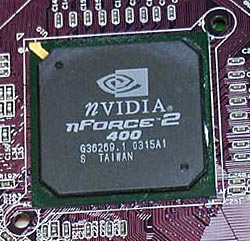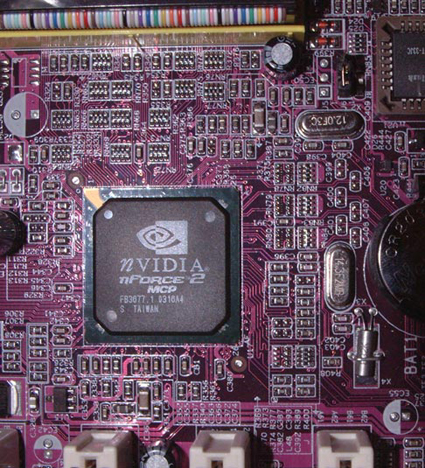Soltek NV400-L64: Purple, Practical, AND Performance!
by Wesley Fink on August 11, 2003 10:26 PM EST- Posted in
- Motherboards
Soltek NV400-L64: Basic Features
| Motherboard Specifications | |
| CPU Interface | Socket-462 |
| Chipset | nForce2 400 Single-Channel North Bridge nForce2 MCP South Bridge |
| Bus Speeds | 100 to 250MHz (in 1MHz increments) |
| PCI/AGP Speeds | Auto (Variable) or Fixed 50-100MHz (in 1 MHz increments) |
| Available CPU Ratios | 5.0X to 22X |
| Core Voltage | 1.10 to 1.85V (in 0.0250V increments) |
| DRAM Voltage | 2.50V to 2.80V (in 0.1V increments) |
| Chipset Voltage | VDD to 1.80V (in 0.1V increments) |
| AGP Voltage | 1.50V to 1.80V (in 0.1V increments) |
| Memory Slots | Two 184-pin DDR DIMM Slots in Single-Channel Configuration |
| Expansion Slots | One AGP 8X Slot Five PCI Slots |
| Onboard IDE | Two Standard ATA133/100/66 (maximum 4 IDE devices) |
| Onboard USB 2.0/IEEE-1394 | Six USB 2.0 ports supported by MCP NO IEEE-1394 FireWire |
| Onboard LAN | nForce MCP 10/100 Ethernet |
| Onboard Audio | Realtek ALC650 codec AC ’97 2.2 Compliant 6-Channel |
| Onboard Serial ATA | None |
| BIOS Revision | Version 1.1 Release BIOS 6/20/2003 |

The Soltek NV400-L64 comes in a slick foil-faced embossed package that is used for many Soltek motherboards. As expected with a value board, extras are a floppy and IDE cable and nothing else. It is worth mentioning, however, that Soltek includes an extra Utility CD with their motherboards that contains PC-Cillin 2002 anti-virus, Farstone’s VirtualDrive 7 and RestoreIT 3 Lite, and Powerquest’s Partition Magic 6.0 SE and DriveImage 4.0. While these are not the latest versions of most of these utilities, they are still utilities that are frequently used. There are two versions of the NV400 listed at the Soltek website. The NV400-L64 and NV400-64 appear the same, except for the 10/100 LAN connection on the NV400-L64, which is the version that we are testing.
Soltek did not use any fancy names for the NV400-L64, but they certainly could have. You can’t help but notice that the board is purple or plum-colored. The purple board is smaller than the full size nForce2 Ultra 400 boards that we have been evaluating, and uses only seven standoffs in two rows for mounting. Full-size boards generally use nine or ten standoffs in three rows for case mounting. This small motherboard should have no trouble fitting into any standard case.

Sound is provided by the common Realtek ALC650 chip, which is compliant with AC ’97 2.2 to provide 6-channel sound. AC ’97 2.2 seems to have replaced older AC ’97 chips, which now makes 6-channel sound mainstream. Audio quality is OK for casual listening or computing, but audio enthusiasts will want to use a separate audio card for top quality. The on-board audio can be disabled in the BIOS if you wish to use a separate audio card. Only the three standard output jacks are provided for audio input and output on the I/O panel, but software that comes with the NV400-L64 does allow the three jacks to be configured for different speaker setups, and the inputs that you might need. This flexible setup is welcomed on a value board, but be aware that with three jacks, you cannot simultaneously run six speakers and a microphone. This will be important for some, and of no consequence to others. As we would expect on a board built for value, there are no SPDIF connectors or provisions for adding an SPDIF bracket to the board.

NVIDIA’s MCP SouthBridge is the value member of the MCP family. It provides USB support, support for one NVIDIA Ethernet connection, and ATA 133 IDE support. The MCP does not support NVIDIA Sound Storm or a second LAN connection — these are additions to the premium MCP-T.
The Soltek NV400-L64 uses the familiar nForce2 10/100 Ethernet for on-board LAN connection. It is becoming common to see LAN included, even on value boards like the NV400. If you prefer using a board without on-board LAN, the alternative is the NV400-64.

The NV400-L64 I/O ports are the same assortment you will find on the standard ATX backplate included with most cases. The arrangement of ports, however, does not follow the standard layout, so Soltek includes a custom backplate. There are two PS/2 ports, two serial ports, one parallel port, two USB 2.0 ports, a 10/100 LAN port, and Mic In, Line In, and Line Out, which drive the onboard sound and are configurable for rear/sub/center outputs if desired. The board does not offer any IEEE1384 Firewire ports, but we don’t normally expect to find Firewire on value motherboards.
There are two ATA133 IDE ports, supporting up to four IDE devices. It is no surprise that the NV400-L64 doesn’t have any on-board IDE RAID or SATA options.
Just two DIMM slots are included on the single-channel Soltek. The two DIMMs support up to 2GB of memory up to DDR400. While up to three DIMMs per channel can be used on the nForce2 400 chipset, Soltek decided to use just two DIMM sockets on the NV400. This is probably an acceptable arrangement on a value board, but we would like to have seen at least one more DIMM slot, since NVIDIA had intended for this Soltek single-channel to compete with KT600 boards with three DIMMs.
There are no real surprises with the Soltek NV400-L64. It includes exactly what we would expect in a value board – no more and no less. The only really distinctive thing about the appearance is the Purple color. The Soltek Utilities CD is also a nice addition for a board designed to sell for such a low price.










35 Comments
View All Comments
Anonymous User - Saturday, August 16, 2003 - link
Wesley -I thought the PCI bus runs at a fixed frequency and is independent from the AGP bus. In the review, it was stated that the PCI bus is half of the AGP bus. Is it possible that this could be confirmed with a hardware monitor that is capable of measuring the PCI bus speed? If not, from what source was the PCI bus speed information taken from?
Thanx for review! :D
Anonymous User - Friday, August 15, 2003 - link
#23, you're clueless. AnandTech still has the best motherboard, CPU and now memory reviews on the net. HardOCP does some of the best video card reviews on the net, a bit better than AnandTech, but that's mostly because Anandtech doesn't release any individual video card reviews. If they did, Anandtech would dominate CPU, motherboard, video AND memory reviews.Read other web sites before you belittle Anandtech for quality reviews.
LMAO at #24. Though your point could have been made better without the swearing. :)
Anonymous User - Thursday, August 14, 2003 - link
Yeah Well ,This review is slightly amusing &Mildly Boring..
For all you new guys at AnandTech,
This place does not feel like "Home" anymore..
Oh yes ,its still my homepage ,after so many years.
The Place Might be Anand's - But it aint Anandtech no more...
THe reviews are lacking & incomplete - with too much cutting & pasting done all the time.
Many issues are just ignored ,
& it all feels so shallow.......
You Should Go Read "Old" Coppermine Area AnandTech Archives & get a grip on what this place used to be...
Please hear My (our?!) cry ..
Locutus4657 - Thursday, August 14, 2003 - link
#5:What the heck are you talking about? Via? Better Stability?? You've obviously never looked into their white papers before.... More than 200 pages for the KT133 errata section alone. I'm sorry, It's worth getting fewer features for an nForce board. At least it will work.
Anonymous User - Thursday, August 14, 2003 - link
Why is it that drivers get so little attention, but small differences in performance are blown up well beyond reasonable proportions? I'm talking about reviews all over the net now and not just Anandtech. It's just that the nForce drivers continuing mess doesn't get even a tenth of the attention that benchmarks in stupid programs like SiSoft Sandra get. (?!?)Wich bothers the users most, a few percentages here and there that doesn't show in practical use or driver issues that makes the regular user call his or her "techy" friend to come solve the issues.
Anonymous User - Thursday, August 14, 2003 - link
Actually, we are only on a limitted relationship with Crucial, Corsair, Kingston and Mushkin. They all send us lots of products, but its fairly easy to do considering how much (or how little) a stick of DDR costs.Evan Lieb - Tuesday, August 12, 2003 - link
In case anyone is wondering, all nForce2 Ultra 400 motherboards from Epox, ASUS, ABIT, etc. vary on an average of 0-1.5% (max). In fact, Gigabyte's nForce2 Ultra 400 motherboard (7NNXP) was ever so slightly faster than ASUS's A7N8X Deluxe rev. 2.0In other words, it serves no purpose to run benchmarks on 10 different nForce2 Ulra 400 motherboards if they all perform the same (unless it's a roundup of course).
Wesley Fink - Tuesday, August 12, 2003 - link
All our benchmarks are run at 1024x768 and at 32bit color if possible. We run the GunMetal 2 bench at default settings - which is audio enabled and 2X Anisotropic filtering. It has been common practice NOT to run Quake3 and other game benches with sound enabled due to the variation in scores caused by different sound chips. However with this new DX9 bench, we decided to run at default.Unfortunately, GunMetal 2 seems VERY video-card bound, and may not be a very useful benchmark for motherboard testing. It would appear a great choice, though, for testing video cards.
Anonymous User - Tuesday, August 12, 2003 - link
Wesley could you please state what settings the gunmetal benchs were run including the resolution, graphical settings ect.. I would like to compare my setup to your results. This info would be benificial if it was stated in the result graphic in the article. Thanks.Wesley Fink - Tuesday, August 12, 2003 - link
#14 - As we stated in #10 and #12, we recently completed retesting ALL recent reviews with our new ATI 9800 PRO video standard. When that was done, benchmarks for this review were updated and sent to our editor who does web-posting.Unfortunately, our web-editor posted the earlier tests. These have NOW been corrected and all reported benchmarks are with the 9800 PRO.
It helps to read all the comments before posting here. Your question or comment may already have been addressed.